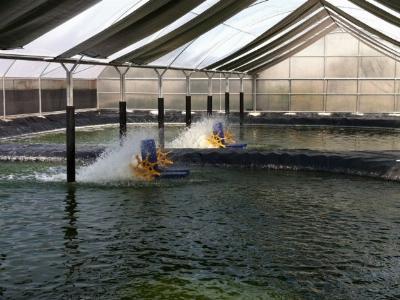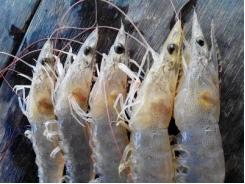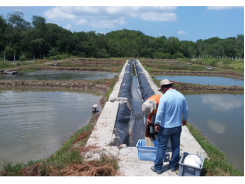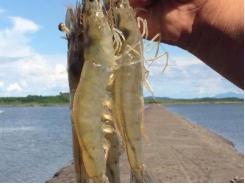Microbial Dynamics in Shrimp Ponds

Understanding the microbial ecological process in ponds and in the shrimp intestinal tract is vital to maintain and optimize productivity without prophylactic use of hazardous substances, write Marcos H. S. Santos, Tadeu de Silva (INVE do Brasil), Jose Torres, Roseli Pimentel Silva (Potipora Brazil), David Moriarty (Centre for Marine Studies, The University of Queensland, Australia and INVE Aquaculture Health, Thailand) and Olivier Decamp (INVE Aquaculture Health, Thailand).
The maintenance of good water quality and the control of disease are closely linked to managing the communities of microbes and phytoplankton.

Healthy shrimp in a pond will be responding to variables that include interactions, with each other, interactions of shrimp and the pond physico-chemical environment (especially oxygen concentration) and interactions of the microbial community, in particular the phytoplankton and the bacteria. As ponds are shallow, water chemistry is infl uenced primarily by the chemistry of the soil and sediment (material settled on to the pond bottom, including dead algae, waste feed and faeces.) These are governed by bacteria activities.
Most organic matter is decomposed by aerobic heterotrophic bacteria in the water column and sediment surface. The remaining organic matter is broken down in the anoxic zone of the sediment mostly by fermentative bacteria, of which clostridia are important constituents, but it also includes vibrios. Short chain fatty acids are the fi nal products of fermentation by these bacteria and they are then used as nutrients by the sulphate-reducing bacteria and respired to CO2. Thus organic matter in the sediment that is not oxidised in aerobic and other respiratory processes will fi nally be converted to carbon dioxide by these bacteria. The toxic hydrogen sulphate is the other main product of this process, and thus it is important that fermentation be minimised in a shrimp pond. The strategy that can used to achieve this is discussed below.
Probotics, which are live, natural, beneficial bacteria, are now accepted and widely used in shrimp aquaculture. They are designed to modify the microbial communities in the alimentary tract of animals and in their aquatic environment and thus also compete with and displace pathogens.
In this article, we report on field data from Potiporã (Queiroz Galvão Group), a major aquaculture company located in RN, Brazil. Their operations at the company include a hatchery unit with an overall production capacity of 150-200 million post larvae per month, an outgrowing farm with 900 ha total pond area, capable of producing up to 6,000 tonnes of shrimp per year from ponds stocked at 18-30/m2, and a processing/packaging plant with a daily capacity of 45 tonnes of shrimp. The company has access to modern techniques (molecular biology, pathology, microbiology) that are used as part of the disease prevention and shrimp genetic programs.
Optimise yields
In 2007, Potiporã started using a range of probotics in their larviculture and ongrowing operations. These were a combination of Sanolife PROFMC (mixture of Bacillus strains, supplied as dry spores, coated on feed by the feed-mill) and Sanolife PRO-W (mixture of Bacillus strains, supplied as dry spores, which was applied directly to the pond water. As part of their quality control analyses, Potipora confirmed the abundance of viable spores and the composition of the commercial products. For example, their Real Time PCR analyses confirmed the absence of Bacillus cereus contaminants from these products.
The combination of Bacillus strains products in feed and water improved the farm productivity, i.e. biomass, survival and profits. As part of their investigation, Potiporã also analyzed numerous water and soil samples in order to understand the microbial dynamics better. These data indicate that the Bacillus strains were abundant in the sediment of the pond (Figure 1).
Figure 1.Abundance of Bacillus and Vibrio (cfu/g soil wet weight) in the sediment of ponds.

Difference in colour in the outlet of Sanolife-treated ponds (light-colour, in the middle of the picture) and control ponds (black water, right side of the picture). Source: Indonesia.
The reasons for higher numbers of the Bacillus in the sediment than in the water column were:
- Bacillus strains would stay in the water suspension during a short time before sinking to the bottom, maybe via the production of flocs. Bacillus are known to produce exopolymer flocculants and laboratory tests confirmed the ability of the Bacillus strains in improving floc production under the right conditions. More interestingly, the Bacillus strains have been shown to improve the nutritional quality of bioflocs (with significantly higher protein and lipid content) and the growth performance of shrimp reared in the presence of probiotic (Ballester and Wasielesky, pers. comm.).
- The Bacillus coated on feed would remain in the uneaten feed pellet and in the faeces that sink to the bottom of the pond. These Bacillus would inhibit pathogens and degrade waste products when the faeces are released into the pond environment. The ability of the Bacillus strains to survive the passage through the shrimp gastrointestinal tract, and germinate, was also evaluated at the IATEC trial facilities (INVE, Thailand). Shrimp were fed for 3 days with either control diet (coated with salmon oil) or Sanolife PRO diet (coated with salmon oil + Sanolife PRO (fi nal concentration 1.5x108 cfu/g). Shrimp faeces were collected and sent immediately to the laboratory for analysis. The analyses confirmed concentration of Bacillus in the shrimp faeces in the order of 1.5x107 cfu/g faeces. With a dry matter of 10.6%, this represents 1.4x108 cfu/g dry faeces.
Inhibit pathogens
As documented in previous publications, these Bacillus species were selected for their ability to inhibit pathogens directly (Figure 2). Furthermore, they inhibit pathogens indirectly by competitive exclusion (ie competition for nutrients and attachment sites in the gut or an algal particles and waste material in ponds.)
These data also confirm the scientific publications suggesting that (1) Gram-positive bacteria comprise a relatively large proportion of the bacterial communities in habiting marine sediments (Gontang et al. 2007, Moriarty and Hayward, 1982);) (2) the dominant species of Bacillus reported from Brazilian marine sediments include B. subtilis, B. licheniformis and B. pumilus (Miranda et al, 2008). The range of probotic includes strains of B. subtilis, B. licheniformis and B. pumilis.
Figure 2. Inhibition of Vibrio strains (Brazilian isolates, horizontal streaks) by a strain of Bacillus (vertical streak).

Conclusion
These data confirm the benfit of using specifically selected strains of Bacillus for their ability to degrade waste organic matter, improve water quality (Figure 4) and out compete Vibrio on the upper sediment layer, the area of the pond where shrimp spend most of their time:
- The continuously produce a wide range of digesive exo-enzymens, which makes them expecially suitable for improving water and sediment quailty and for assisting digestion in the shrimp mid gut.
- Bacillus grow aerobically and certain selected strains also live in the absence of oxygen or at low oxygen tension, allowing them to live in the mid gut of shrimp as well as in anoxic sediment particles.
Acknowledgement
This article was originally at the Aqua Culture AsiaPacific Magazine.
Related news
Tools

Phối trộn thức ăn chăn nuôi

Pha dung dịch thủy canh

Định mức cho tôm ăn

Phối trộn phân bón NPK

Xác định tỷ lệ tôm sống

Chuyển đổi đơn vị phân bón

Xác định công suất sục khí

Chuyển đổi đơn vị tôm

Tính diện tích nhà kính

Tính thể tích ao




 Effect of a Functional Feed Additive on Productivity…
Effect of a Functional Feed Additive on Productivity…  Prevention of White Feces Syndrome, White Gut Disease…
Prevention of White Feces Syndrome, White Gut Disease…